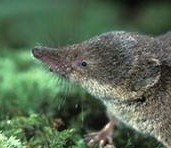 In literature a shrew is a woman of violent temper or speech but in the garden it is an animal with some notable virtues. There are over 250 different kinds of shrews in the world and over 30 in the US. They range in size from 1 1/2 inches to two inches long, and have an elongated snout, small eyes, dense fur, and five toes. (Mice have shorter snouts, larger eyes, and four toes)
In literature a shrew is a woman of violent temper or speech but in the garden it is an animal with some notable virtues. There are over 250 different kinds of shrews in the world and over 30 in the US. They range in size from 1 1/2 inches to two inches long, and have an elongated snout, small eyes, dense fur, and five toes. (Mice have shorter snouts, larger eyes, and four toes)
1. Although they resemble mice they are not rodents like mice because they have sharp pointed teeth rather than the long gnawing teeth of rodents.
2. Shrews are beneficial animals in the garden by eating a variety of pests including snails, slugs, pill bugs, moth larvae, and mice.
3. They also eat other desirable animals such as butterfly larvae, ichneumonid wasps, earthworms, and small birds.
4. Shrews have a high metabolic rate and can consume from 1/2 to three times their body weight every day.
5. The life span of a shrew is about two years but in that time a female can have four
to ninety offspring depending on the species and the climate.
6. Hearing, smell, and touch are well developed in shrews but sight is not (because they live mostly underground, often in the tunnels of moles and voles).
7. Like bats, shrews have an echolocation system but unlike bats they use it to explore their habitat and find food.
8. Some shrews produce a foul smelling substance that helps ward off predators although owls are not much affected by it and are major predators.
9. A toxic substance in the saliva of some shrews helps them kill their prey; (A substance in the venom of the short-tailed shrew has been used to treat ovarian cancer)
10. Shrews are not usually considered pests to gardeners and over all are important in controlling insect populations.